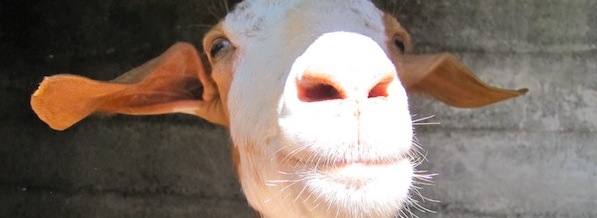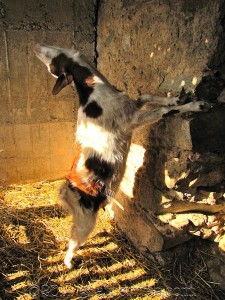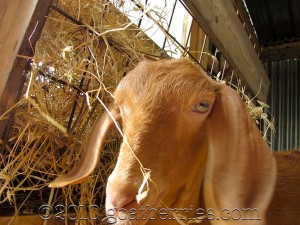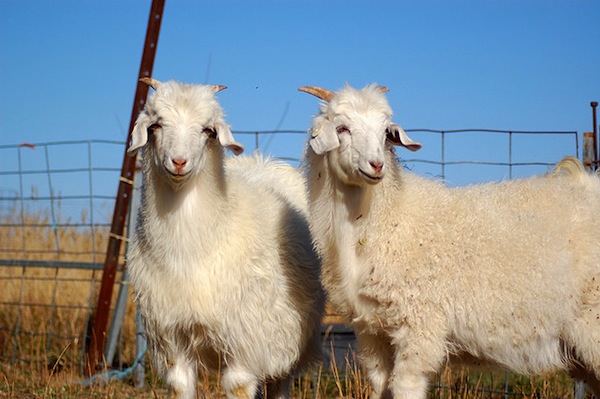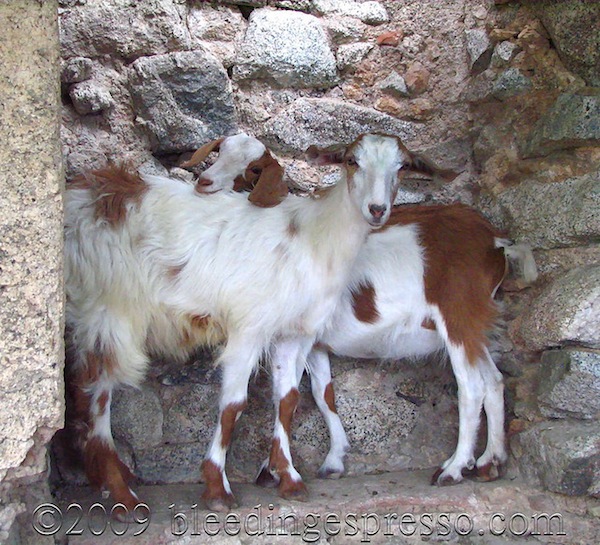Archive for the ‘Goat Questions’ Category
The Goat Spot Forum App for iPhone/iPad & Android
Here’s a great new app for goat raisers: The Goat Spot Forum for both iPhone/iPad and Android.
Read on...Goatlightenment: How Do I Get My Goats to Love Me?
How can you get a stubborn goat to let you pet him? Read on.
Read on...Horns or No Horns on Goats — Which is Better?
Faithful reader Renee posed a question on the Goat Berries Facebook page recently: What do we goat people feel about horns? I thought this was a great question for discussion, so I’m posting it here — please do add your thoughts on the issue as it can help other goat people make some tough decisions.
First, for anyone who doesn’t know, horns don’t go by sex; that is, you both females and males may have horns. It is a genetic trait (kind of like those adorable wattles), so if you’re breeding goats with horns, you’re probably, although not definitely, going to end up with kids with horns.
My girls are both naturally polled (born without horns), so the horn issue isn’t something we dealt with directly *but* we did aim for hornless, so I suppose you can say that I’m on the “no horn” side –beautiful as they can be. Just look at this dude:
From what I’ve read, anecdotes about how dangerous horns can be were the most persuasive to me. Goat horns can be dangerous not only for the goat caretakers and their families but also for fellow goats and other animals; goats do tend to headbutt in play and sometimes aggression and can do serious damage to others in either case.
Then there’s the possibility of the horns getting stuck in fences, etc., and putting the goat in other compromising positions, which can not only cause stress and difficulty in freeing itself (the goat can do major damage and even kill itself trying to get free), but it can also leave him or her exposed to predators — even a dog can kill a goat if it really wants to.
On the flip side, some people argue that disbudding is inhumane and unnatural as horns are goats’ natural defenses and help them cool off as sweat glands.
There’s a good discussion of this issue from a long-time goat caretaker at Fias Co. Farm, so I highly recommend heading over there for more information on this as well as on proper disbudding procedures. For the uninitiated, “disbudding” is the process of removing goat’s horns and really isn’t for the faint of heart — and quite painful for the kids too. Note that you should disbud within the first week of the kid’s life, so if you’re about to have kids, this is something you should think about sooner rather than later so you’re prepared.
For our goat-raising situation, I’d say disbudding would be best for us if faced with the horn dilemma — but this is a personal decision, of course, and I’d love to hear your take on it.
So, goat peeps, what is your position on horns? Do you goats have horns? If your goats get disbudded, do you do it yourself? Also, are your goats mixed — some polled, some horned? How does that work out?
Why Is My Goat Crying and Restless?
I got a question from a reader recently asking what might be wrong with a goat that is crying and restless. Great timing, in fact, because I myself have a goat who is crying and restless — Signorina Pasqualina.
We’ll get back to her in the next post (stay tuned!), but first, and I can’t stress this enough, it is extremely important that you know your goat when trying to diagnose what the problem might be. That is, you need to know your goat’s normal behavior in order to tell if something is off — and not all goats act the same in normal circumstances, so it can be difficult to generalize. My overriding rule is that if you feel something is off, it probably is, so pay attention. But what are you looking for?
What Kind of Crying Is It?
First of all, ask yourself: what kind of cry is it? If you know your goat, you know what s/he sounds like most of the time — and you’ll definitely know the difference between normal “Hey maaaa I’m here!” bleating and any kind of pain or distress. Quick example: when Pasqualina was just a wee kid, she got herself tangled in a cord and believe-you-me, even from a pretty good distance, I knew that bleat was not just for fun and games; she was terrified (although not injured, thank goodness).
One important question to ask at this stage is whether your goat has a buddy. It doesn’t have to be another goat necessarily, but goats are social animals, and they like company. So your goat may just be crying because it’s lonely and wants some attention. But if your goat has company and suddenly starts crying for no reason, read on.
Reasons Why a Goat Might Be Crying
Once you’re pretty sure there’s something else behind the cry other than just trying to get your attention, you should look for other symptoms or behaviors that aren’t normal for your goat so you can narrow down what might be wrong with him or her. Goat bloat is where my mind always turns when I think of goat health problems, so let’s go there first.
Symptoms of Goat Bloat
Other than crying in pain, the telltale symptom of goat bloat is a larger than usual (and larger than the other side), distended left side of the goat, where the rumen is located. Goats with bloat may also show other signs of being uncomfortable like teeth grinding, kicking at their sides, and just seeming generally depressed. You should put your ear up close to the rumen and check for gurgling sounds — there should be some if the rumen is working correctly. If the bloat is more severe, a goat may also have trouble breathing.
I’ll be writing more about goat bloat and other goat illnesses in the future for handy reference, but for now, know that if you think you goat has bloat, you should first check and make sure there are no obstructions in the mouth or throat; generally you can just run your hands down the throat and feel for anything out of place. You can then start massaging his or her sides to kind of loosen up the gas that’s in there, focusing on the upper left, kind of like you’re burping a baby — your goat will hopefully start making some burps, etc. and release some gas. If some air has escaped, you can then offer some baking soda to further help balance that pH in there.
For lots more detailed information on goat bloat, visit Fias Co Farm.
There are many other illnesses a goat could have, though, so be sure to check any and all symptoms before just deciding your goat is wanting attention. Here is a handy list of potential goat illnesses along with their symptoms at from GoatWorld.
One thing we haven’t touched on, though, as a reason your doe might be crying is that she’s in heat — which is exactly what we’re going to talk about next time using our Pasqualina as a case study.
Goatlightenment: Can You Shave Goats for Their Hair?
Faithful reader and goat lover, the lovely 8-year-old LuccaBella in Italy has written to me to ask:
Can you shave goats hair? Because lambs you can shave hair & you can make clothes & cotton. Can you do that with goats?
This is an *excellent* question, and something I bet many people don’t know about . . . because cashmere (that oh-so-soft, wonderfully warm sweater and sock material) actually comes for goats. The cashmere goat, in fact.
Yes, cashmere wool comes from the soft, fluffy, fine-haired undercoat of these gorgeous goats:
As many of you probably know, cashmere wool products will keep you super warm and cozy throughout the winter, which is exactly why these goats have their coats. Cashmere goats tend to live in cold, often mountainous climates and begin moulting (losing their hair) in the spring as they’ll no longer need that undercoat to keep warm throughout the summer.
And that’s where cashmere producers come in.
The cashmere from goats may be gathered by combing through or shearing the hair. In order to collect what will become cashmere for clothes and other fabrics, the fine hair of the undercoat must be separated from the coarser hair of the outer coating (called guard hair). The guard hair may be used for brushes and other non-clothing items.
*
In fact, LuccaBella, you and your Mamma might be interested to learn more about Chianti Cashmere run by American expat Nora Kravis (who has given me great advice on finding goat minerals) — not too far from where you live. Nora offers handwoven products, and her farm prides itself in leaving “no carbon hoofprint” with its Sustainable Cashmere® movement.
*
Now, if you’re wondering whether Pasqualina and Pinta produce wool for clothes, the answer is no. They just aren’t that type of goat, and in fact, they both have quite fine hair. Here in Calabria, our dairy goats (like Pasqualina) don’t tend to have very thick hair because they don’t need it as temperatures don’t drop below freezing very often in the winter. That said, some of the other breeds of goats around here do have thicker hair (you may remember Carmelina for instance), but even they are not shaved for wool — they just aren’t that kind of goat either.
Thanks so much for the question — I hope my answer helped clear it up!
By the way, for answers to many goat questions, check out The Maaaaa of Pricilla’s excellent “goatucation” series.
Goat Shelters: How Good are PolyDomes?
The other day I got a message from Goat Berries readers Heidi and Paul, who have just started keeping goats. Check out how cute their Nubian and La Mancha are!
Heidi and Paul have purchased a PolyDome for shelter because they had heard how great they were for warmth and ventilation, and this is where their question comes in:
“However, since it was delivered (we ordered it over the internet), we have had someone tell us that it is horrible to keep the girls in. They said it won’t keep them warm. Now that we can see it firsthand, we are confused about how to keep good ventilation and yet keep them free from drafts. Any thoughts on this issue?”
I personally don’t know very much about PolyDomes as I don’t think they’re popular in Italy (at least I’ve never seen them used or for sale), but I did some quick Google searching, and came up with some examples of people using PolyDomes for goats without problems (one person wrote he put plastic flap doors on the front). I also found that one particular PolyDome for calves comes with a ventilation system that you can adjust with the weather.
But I’m not sure this helps Heidi and Paul very much, so I’m looking to you, experienced goat caretakers — do you know anything about PolyDomes and how good they are for keeping goats warm? Please feel free to pass around the question among goat circles you know . . . inquiring minds want to know!
Any and all information is greatly appreciated!


